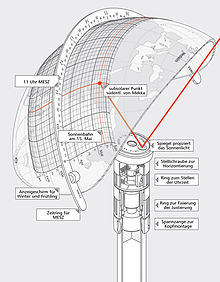Subsolar point

A point on a planet or moon is called subsolar ( Latin under the sun ) when the sun is at its zenith . There is also True Noon . The subsolar latitude is the declination of the sun and, like this, oscillates between the tropics over the course of a year . On a globe sundial (top illustration) the point showing the time of day and season is also the current subsolar point .
At the subsolar point of a celestial body, the current insolation is maximum. The degree of latitude with the maximum daily mean of the insolation is not the subsolar degree of latitude, but shifted further towards the poles (to longer day lengths) the greater the amount of the subsolar latitude is.

In global maps of solar eclipses (lower figure), the subsolar point is drawn for the time of the greatest eclipse , i.e. when the shadow axis comes closest to the center of the earth.
Individual evidence
- ↑ a b Fred Espenak , NASA's GSFC: Solar Eclipse Figures .
- ^ Raymond T. Pierrehumbert: Principles of Planetary Climate . Cambridge 2010, ISBN 978-0-521-86556-2 , limited preview in Google Book Search.